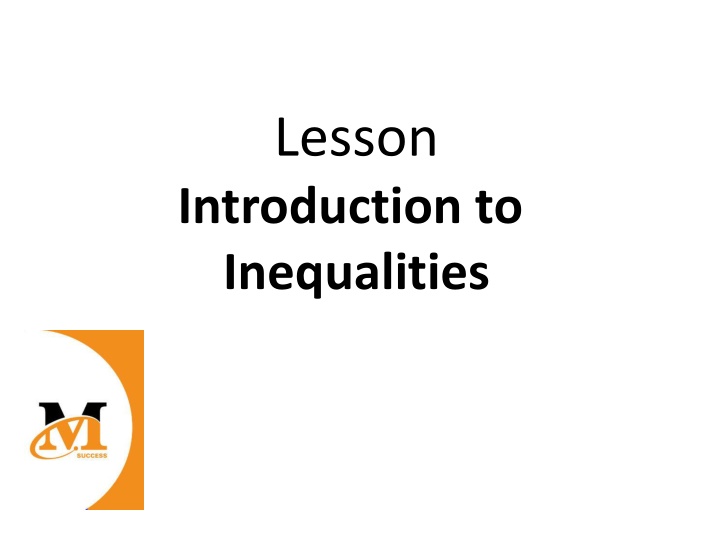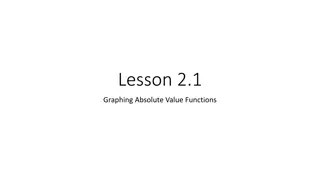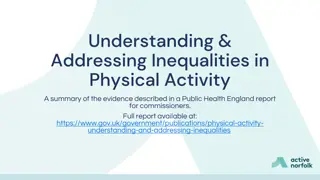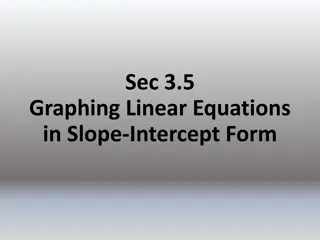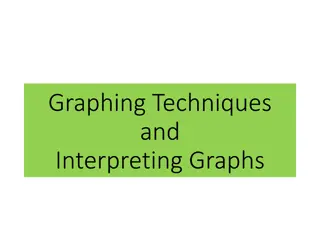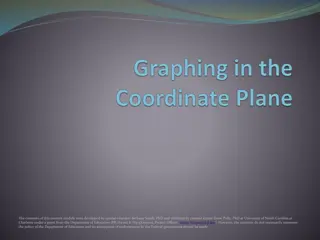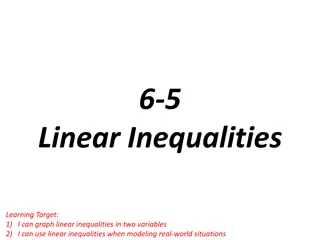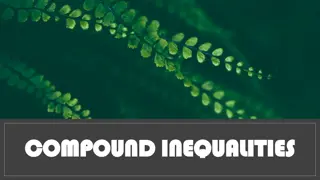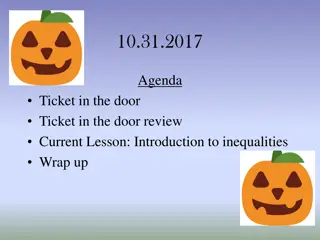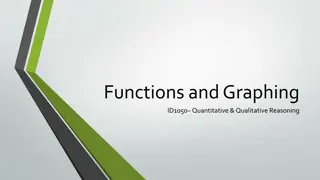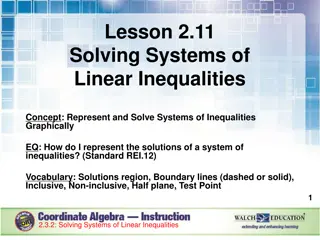Inequalities Through Writing, Solving, and Graphing
Delve into the world of inequalities with this lesson, where you will learn to write and solve one-step inequalities for both mathematical and real-world scenarios. By the end, you will be able to graph the solutions on number lines, enhancing your understanding of this fundamental concept in mathematics.
Download Presentation

Please find below an Image/Link to download the presentation.
The content on the website is provided AS IS for your information and personal use only. It may not be sold, licensed, or shared on other websites without obtaining consent from the author.If you encounter any issues during the download, it is possible that the publisher has removed the file from their server.
You are allowed to download the files provided on this website for personal or commercial use, subject to the condition that they are used lawfully. All files are the property of their respective owners.
The content on the website is provided AS IS for your information and personal use only. It may not be sold, licensed, or shared on other websites without obtaining consent from the author.
E N D
Presentation Transcript
Lesson Introduction to Inequalities
[OBJECTIVE] The student will write and solve one-step inequalities that represent mathematical and real-world situations and graph the solutions on number lines
[MYSKILLS] Solving equations Writing expressions Writing equations
[ESSENTIALQUESTIONS] 1. How does the solution of the inequality x + 6 < 10 differ from the solution of the equation x + 6 = 10? 2. When do you use an open circle when graphing an inequality? A closed circle? 3. Explain how to check the solution to an inequality.
[Warm-Up] Begin by completing the warm-up for this lesson.
SOLVE Problem Introduction INTRODUCTION TO INEQUALITIES
[LESSON] SOLVE Jennifer and 3 of her friends are going to a concert. The price of a ticket includes entrance to the concert, a CD, and a T-shirt. The total cost of the tickets is more than $48.00. How could you represent the cost of one ticket?
[LESSON] SOLVE S Study the Problem Underline the question.
[LESSON] SOLVE Jennifer and 3 of her friends are going to a concert. The price of a ticket includes entrance to the concert, a CD, and a T-shirt. The total cost of the tickets is more than $48.00. How could you represent the cost of one ticket?
[LESSON] SOLVE S Study the Problem Underline the question. This problem is asking me to find the way to represent the cost of one ticket.
Inequality Symbols Expression Writing with Symbols 1. six is less than eight 2. four is greater than two 3. x is less than or equal to five 4. c is greater than or equal to one 5. three is less than seven 6. twelve is greater than nine 7. b is less than or equal to ten 8. y is greater than or equal to eleven What do you notice about the expressions in Column 1? The expressions are verbal expressions that compare values.
Inequality Symbols Expression Writing with Symbols 1. six is less than eight 2. four is greater than two 3. x is less than or equal to five 4. c is greater than or equal to one 5. three is less than seven 6. twelve is greater than nine 7. b is less than or equal to ten 8. y is greater than or equal to eleven What do you notice about Column 2? Column 2 is a translation of the verbal expression in Column 1 using symbols and numbers
Inequality Symbols Expression 1. six is less than eight Writing with Symbols 11 12 13 14 15 10 6 9 5 7 8 4 3 2 1 What are the two number values? 6 and 8 Place a centimeter cube on each of the values on the number line at the bottom of the page.
Inequality Symbols Expression 1. six is less than eight Writing with Symbols 6 < 8 11 12 13 14 15 10 6 9 5 7 8 4 3 2 1 Which value is less? 6 We can write the relationship between the two values using the symbol for less than. 6 < 8
Inequality Symbols Expression 2. four is greater than two Writing with Symbols 11 12 13 14 15 10 6 9 5 7 8 4 3 2 1 What are the two number values? 4 and 2 Place a centimeter cube on each of the values on the number line at the bottom of the page.
Inequality Symbols Expression 2. four is greater than two Writing with Symbols 4 > 2 11 12 13 14 15 10 6 9 5 7 8 4 3 2 1 Which value is greater? 4 We can write the relationship between the two values using the symbol for greater than. 4 > 2
Inequality Symbols Expression 3. x is less than or equal to five Writing with Symbols 11 12 13 14 15 10 6 9 5 7 8 4 3 2 1 How is the expression in Problem 3 different from the expressions in Problems 1 and 2? The expression in Problem 3 contains a variable.
Inequality Symbols Expression 3. x is less than or equal to five Writing with Symbols 11 12 13 14 15 10 6 9 5 7 8 4 3 2 1 Explain why we use a variable. We use a variable to represent an unknown value What are the two values in Problem 3? x and 5
Inequality Symbols Expression 3. x is less than or equal to five Writing with Symbols x 5 11 12 13 14 15 10 6 9 5 7 8 4 3 2 1 What is the relationship between the two? x is less than or equal to 5. We can write that relationship using the sign for less than or equal to. x 5
Inequality Symbols Expression 4. c is greater than or equal to one Writing with Symbols 11 12 13 14 15 10 6 9 5 7 8 4 3 2 1 How is the expression in Problem 4 different from the expressions in Problems 1 and 2? The expression in Problem 4 contains a variable.
Inequality Symbols Expression 4. c is greater than or equal to one Writing with Symbols 11 12 13 14 15 10 6 9 5 7 8 4 3 2 1 Explain why we use a variable. We use a variable to represent an unknown value What are the two values in Problem 4? c and 1
Inequality Symbols Expression 4. c is greater than or equal to one Writing with Symbols c 1 11 12 13 14 15 10 6 9 5 7 8 4 3 2 1 What is the relationship between the two? c is greater than or equal to 1. We can write that relationship using the sign for greater than or equal to. c 1
INEQUALITY SYMBOLS WITH REAL- WORLD SITUATIONS
Inequality Symbols with Real-World Situations Expression Inequality Graph 1. John has less than 15 video games. 15 16 17 14 13 Identify the values in Problem 1. 15 video games and a variable to represent how many games John has Let s use the variable j to represent the number of video games that John has.
Inequality Symbols with Real-World Situations Expression Inequality Graph 1. John has less than 15 video games. j < 15 15 16 17 14 13 How can we write the relationship using a variable, numbers, and symbols? j < 15
Inequality Symbols with Real-World Situations Expression Inequality Graph 1. John has less than 15 video games. j < 15 15 16 17 14 13 This relationship is called an inequality. Why is this relationship called an inequality? The two values are not equal. One is less than the other.
Inequality Symbols with Real-World Situations Expression Inequality Graph 2. Penny invited more than 6 friends to her birthday party. 8 5 6 7 4 Identify the values in Problem 2. 6 friends and a variable to represent how many friends were invited in total. Let s use the variable p to represent the number of friends at the birthday party.
Inequality Symbols with Real-World Situations Expression Inequality Graph 2. Penny invited more than 6 friends to her birthday party. p > 6 8 5 6 7 4 How can we write the relationship using a variable, numbers, and symbols? p > 6
Inequality Symbols with Real-World Situations Expression Inequality Graph 3. There are at least 20 students in the math class 20 21 22 19 18 Identify the values in Problem 3. 20 students and a variable to represent the total number of students in the class. Let s use the variable m to represent the number of students in the math class.
Inequality Symbols with Real-World Situations Expression Inequality Graph 3. There are at least 20 students in the math class m 20 20 21 22 19 18 How can we write the relationship using a variable, numbers, and symbols? m 20
Inequality Symbols with Real-World Situations Expression Inequality Graph 4. Kyle could spend no more than $12 at the school carnival 12 13 14 11 10 Identify the values in Problem 4. $12 and a variable to represent the amount he can spend at the carnival. Let s use the variable k to represent the amount that Kyle can spend at the carnival.
Inequality Symbols with Real-World Situations Expression Inequality Graph 4. Kyle could spend no more than $12 at the school carnival k 12 12 13 14 11 10 How can we write the relationship using a variable, numbers, and symbols? k 12
Inequality Symbols with Real-World Situations Expression Inequality Graph 1. John has less than 15 video games. j < 15 15 16 17 14 13 Take a look back at Problem 1. What do we know about the value of j? It is less than 15.
Inequality Symbols with Real-World Situations Expression Inequality Graph 1. John has less than 15 video games. j < 15 15 16 17 14 13 What do you notice about the numbering on the graph in Column 3? It has 5 values and the middle value is 15.
Inequality Symbols with Real-World Situations Expression Inequality Graph 1. John has less than 15 video games. j < 15 15 16 17 14 13 When we graph an inequality, we draw a circle at the point of the value given in the inequality. Where do we draw the circle? 15 Draw the circle.
Inequality Symbols with Real-World Situations Expression Inequality Graph 1. John has less than 15 video games. j < 15 15 16 17 14 13 Are we including 15 in our possible answers? No When the value is not included, we use an empty circle.
Inequality Symbols with Real-World Situations Expression Inequality Graph 1. John has less than 15 video games. j < 15 15 16 17 14 13 When we have an equation, how many solutions are there? 1 When we have an inequality, how many solutions are there? many
Inequality Symbols with Real-World Situations Expression Inequality Graph 1. John has less than 15 video games. j < 15 15 16 17 14 13 We can show the solution set for the inequality by drawing a ray from the point on the number line. Which direction should we draw the ray? Explain your answer. We draw the ray from the point at 15 to the left because our solution must be less than 15.
Inequality Symbols with Real-World Situations Expression Inequality Graph 2. Penny invited more than 6 friends to her birthday party. p > 6 8 5 6 7 4 When we graph an inequality, we draw a circle at the point of the value given in the inequality. Where do we draw the circle? 6 Draw the circle.
Inequality Symbols with Real-World Situations Expression Inequality Graph 2. Penny invited more than 6 friends to her birthday party. p > 6 8 5 6 7 4 Are we including 6 in our possible answers? No When the value is not included, we use an empty circle.
Inequality Symbols with Real-World Situations Expression Inequality Graph 2. Penny invited more than 6 friends to her birthday party. p > 6 8 5 6 7 4 Which direction should we draw the ray? Explain your answer. We draw the ray from the point at 6 to the right because our solution must be greater than 6.
Inequality Symbols with Real-World Situations Expression Inequality Graph 3. There are at least 20 students in the math class m 20 20 21 22 19 18 When we graph an inequality, we draw a circle at the point of the value given in the inequality. Where do we draw the circle? 20 Draw the circle.
Inequality Symbols with Real-World Situations Expression Inequality Graph 3. There are at least 20 students in the math class m 20 20 21 22 19 18 Are we including 20 in our possible answers? Yes When the value is included, we use a filled in circle.
Inequality Symbols with Real-World Situations Expression Inequality Graph 3. There are at least 20 students in the math class m 20 20 21 22 19 18 Which direction should we draw the ray? Explain your answer. We draw the ray from the point at 20 to the right because our solution must be greater than or equal to 20.
Inequality Symbols with Real-World Situations Expression Inequality Graph 4. Kyle could spend no more than $12 at the school carnival k 12 12 13 14 11 10 When we graph an inequality, we draw a circle at the point of the value given in the inequality. Where do we draw the circle? 12 Draw the circle.
Inequality Symbols with Real-World Situations Expression Inequality Graph 4. Kyle could spend no more than $12 at the school carnival k 12 12 13 14 11 10 Are we including 12 in our possible answers? Yes When the value is included, we use a filled in circle.
Inequality Symbols with Real-World Situations Expression Inequality Graph 4. Kyle could spend no more than $12 at the school carnival k 12 12 13 14 11 10 Which direction should we draw the ray? Explain your answer. We draw the ray from the point at 12 to the left because our solution must be less than or equal to 12.
Inequality Symbols with Real-World Situations Expression Inequality Graph 5. SAMPLE: There are less than 3 cookies for each student x < 3 5 2 3 4 1 How are Problems 5 8 different from Problems 1 4? The inequality is given, but no situation. What are some possible real-world scenarios for Problem 5? Sample: there are less than 3 cookies for each student.
Inequality Symbols with Real-World Situations Expression Inequality Graph 5. SAMPLE: There are less than 3 cookies for each student x < 3 5 2 3 4 1 How can we graph this inequality? Where will we place the circle? Above the 3 Is the circle open or filled in? Explain your answer. The circle will be open because the inequality tells us the solution set is less than 3 and does not include the value of 3.
